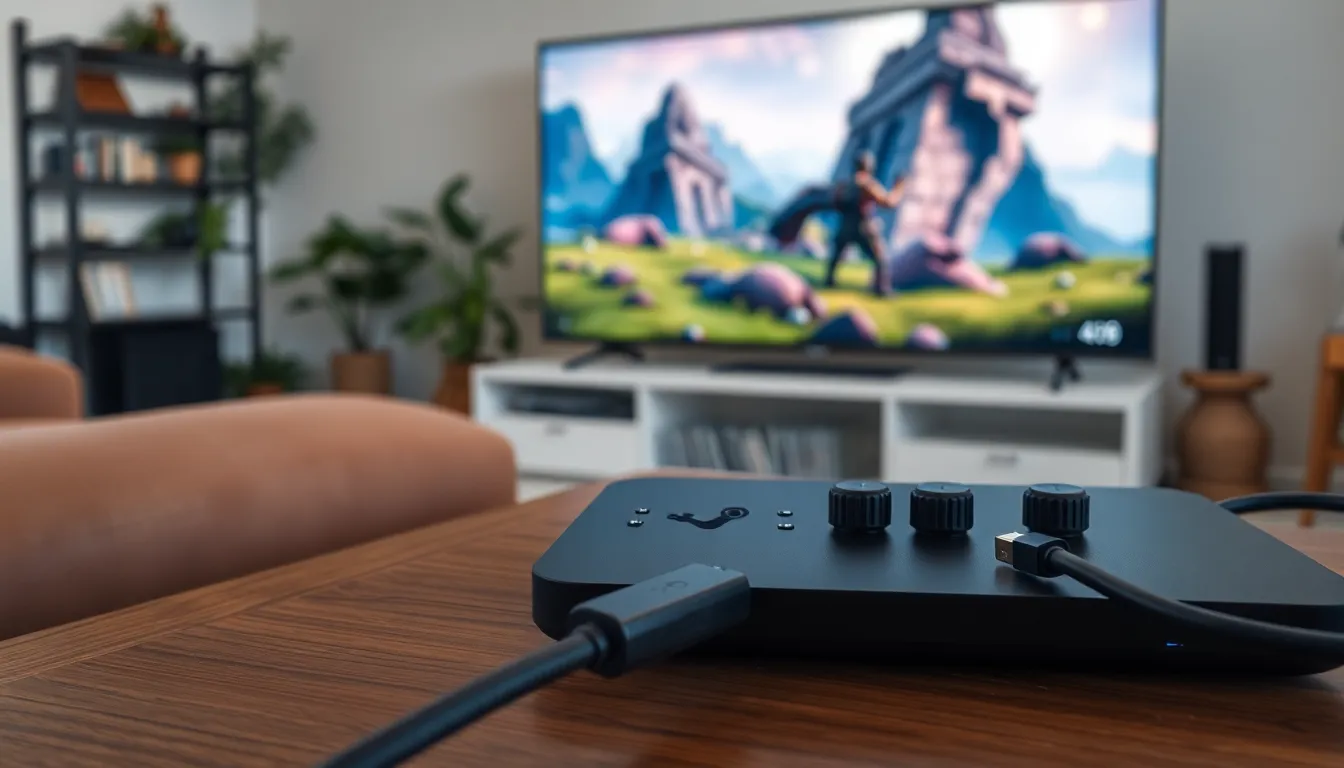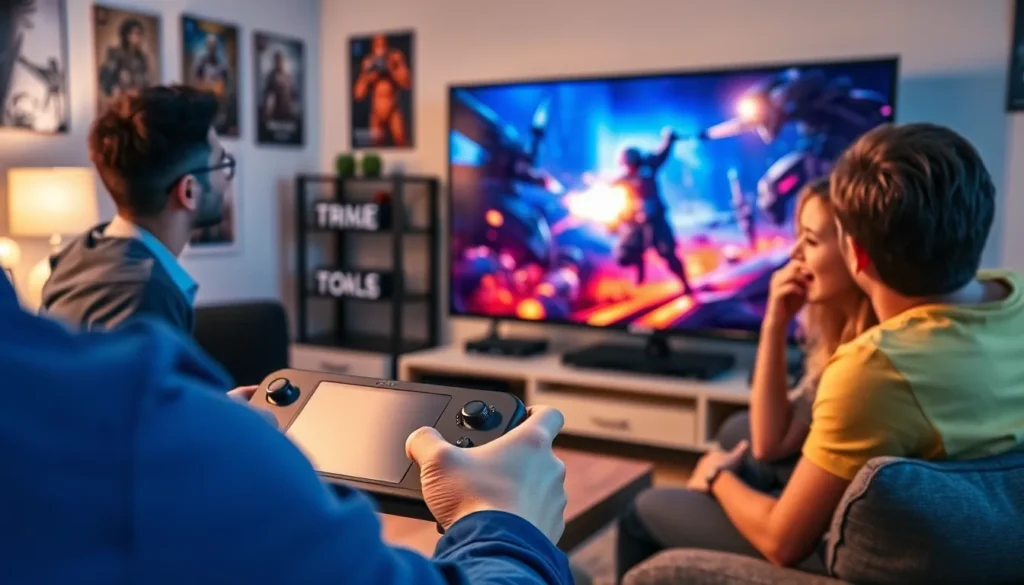The Steam Deck has taken the gaming world by storm, but what if it could do more than just play your favorite titles on the go? Enter the HDMI port, your gateway to transforming that handheld powerhouse into a full-fledged gaming console. Imagine the thrill of blasting through your favorite games on a massive screen, all while your friends marvel at your gaming prowess.
Table of Contents
ToggleOverview of Steam Deck HDMI
Steam Deck features an HDMI port that enhances gaming experiences. This port enables users to connect the device to TVs, monitors, or projectors. Connecting to a larger screen significantly improves visibility and immersion in gameplay.
Using an HDMI cable, the device supports resolutions up to 4K at 60 Hz. Gamers appreciate this capability, especially for playing visually demanding titles. The convenience of instant connectivity allows seamless transitions between handheld and docked modes.
Moreover, the device’s HDMI functionality ensures support for various audio formats, providing high-quality sound output. Users benefit from both video and audio being delivered through a single cable, simplifying setups.
Connecting multiple external devices is straightforward. Players can integrate peripherals like keyboards and mice for enhanced control. A significant number of users enjoy local multiplayer sessions on larger displays, showcasing their skills to friends.
While utilizing the HDMI port, maintaining optimal performance is vital. Ensuring that appropriate settings for resolution and refresh rate are selected maximizes visual quality. Various accessories, such as docks or adapters, can further expand connectivity options, including USB hubs for additional peripherals.
Steam Deck’s HDMI port delivers a versatile gaming solution. The ability to connect to larger displays transforms gameplay, creating opportunities for social interactions and enhanced experiences. As a result, users can enjoy their favorite games on a grand scale.
Features of Steam Deck HDMI

The Steam Deck HDMI port significantly enhances the gaming experience by offering impressive video and audio support. It opens new possibilities for connecting the device to larger screens.
Video Output Capabilities
Steam Deck HDMI supports up to 4K resolution at 60 Hz, providing crystal-clear visuals. Gamers benefit from this high resolution, especially when playing graphically intensive titles. Connecting to TVs and monitors becomes seamless, enabling a smooth transition from handheld to console mode. The device automatically adjusts to the display’s capabilities, ensuring optimal output. In addition, users can choose various aspect ratios for compatibility with different screen sizes. Multiple output options enhance flexibility, making it suitable for various gaming setups.
Audio Support
High-quality audio output accompanies the brilliant video features. Steam Deck HDMI transmits both audio and video through a single cable, simplifying connections. Gamers enjoy immersive sound through external speakers or home theater systems. The device supports various audio formats for an enriched listening experience. Adjusting audio settings through the Steam Deck interface is user-friendly, allowing for customization based on preferences. This comprehensive audio support complements the video capabilities, elevating the overall gaming experience on larger displays.
Connecting Steam Deck HDMI
Connecting the Steam Deck to an external display enhances the gaming experience significantly. Various methods exist for establishing a seamless connection.
Required Cables and Adapters
Users need a USB-C to HDMI cable or adapter for connection. Many seek adapters that support 4K at 60 Hz for optimal performance. A standard HDMI cable works well, ensuring compatibility with most TVs and monitors. Additionally, while some displays may require specific settings, most modern displays automatically detect connection types. Selecting the right adapter may streamline the process, allowing for an immediate setup.
Step-by-Step Connection Guide
Begin by powering off the Steam Deck. Connect the chosen USB-C to HDMI adapter to the device’s USB-C port. Attach the HDMI cable from the adapter to an available HDMI port on the display. Turn on the external display first, followed by powering on the Steam Deck. Wait for the device to automatically detect the external display. Users can adjust display settings through the Steam Deck interface, ensuring the resolution matches the preferences. Closing the setup is easy, allowing for quick transitions back to handheld mode.
Performance and Compatibility
The Steam Deck’s HDMI capabilities significantly enhance gaming performance. Users experience a more immersive environment when connecting to larger screens. A wider display offers better visibility, allowing players to fully appreciate vibrant graphics and intricate details in games. Many enjoy multiplayer sessions on TVs, with friends gathering for competitive gameplay.
Gaming Experience
Gamers notice a marked improvement in the overall gaming experience with the HDMI output. Visual clarity becomes evident, as textures and animations appear smoother on bigger screens. Enhanced audio accompanies the visuals, as sound travels through external speakers or home theaters, creating an engaging atmosphere. The Steam Deck automatically optimizes settings based on the connected display, removing any hassle. Various aspect ratios provide flexibility, making it easy for users to adjust content to fit diverse screen types. This seamless transition between handheld and docked modes elevates both solo and social gaming sessions.
Supported Resolutions and Refresh Rates
The Steam Deck HDMI port supports impressive resolutions and refresh rates. Users can enjoy gameplay in stunning 4K resolution at up to 60 Hz, making it suitable for visually demanding titles. Enhanced refresh rates improve frame rates in action-packed scenes, ensuring smooth gameplay. Compatibility extends to a range of resolutions beyond 4K, allowing gamers to select options that best match their displays. Connecting to different monitors or TVs won’t affect the gaming experience negatively, as the HDMI port adjusts output automatically. This adaptability caters to various setups, ensuring that gamers receive optimal performance regardless of the screen used.
Troubleshooting Common Issues
Resolving issues with the Steam Deck’s HDMI connection involves several steps. First, check the cables and adapters used to connect the device. A USB-C to HDMI cable or adapter must support 4K at 60 Hz for optimal performance. Ensuring the cable is securely connected to both the Steam Deck and the external display can prevent connection problems.
Identifying display settings may also require adjustment. Users must verify resolution settings on both the Steam Deck and the external screen, ensuring compatibility. If the output resolution doesn’t match the display’s capabilities, visual output may be compromised.
Rebooting the Steam Deck often resolves temporary glitches. After power cycling the device, users may notice improved performance and reliability when reconnecting via HDMI. Additionally, testing the HDMI connection with different displays or gadgets can help isolate the issue.
Audio issues can arise alongside video problems. Adjusting the audio output settings within the Steam Deck’s menu guarantees that sound routes through the HDMI connection. Confirming that external speakers or a home theater system is selected as the audio source is crucial for optimal sound quality.
Resetting the system or checking for software updates may also benefit the overall experience. Ensuring that the Steam Deck runs the latest software eliminates bugs, enhancing compatibility with various external displays.
Users encountering persistent issues can consider reaching out to customer support. The Steam Deck community also offers forums where players share experiences and solutions for HDMI-related problems, fostering a collaborative troubleshooting environment.
The Steam Deck’s HDMI capabilities transform gaming into a visually stunning and immersive experience. By connecting to larger displays, users unlock enhanced graphics and sound quality that elevate gameplay. The flexibility of aspect ratios and automatic adjustments to display settings ensure compatibility across various devices, making it easy for gamers to switch between handheld and docked modes.
With support for impressive resolutions and refresh rates, the Steam Deck stands out as a versatile gaming solution. Whether showcasing skills to friends or enjoying solo sessions, the HDMI port enhances every aspect of gaming. Troubleshooting tips further empower users to make the most of their setup, ensuring seamless connectivity and optimal performance. Embracing the Steam Deck’s HDMI features opens the door to a richer gaming experience.






